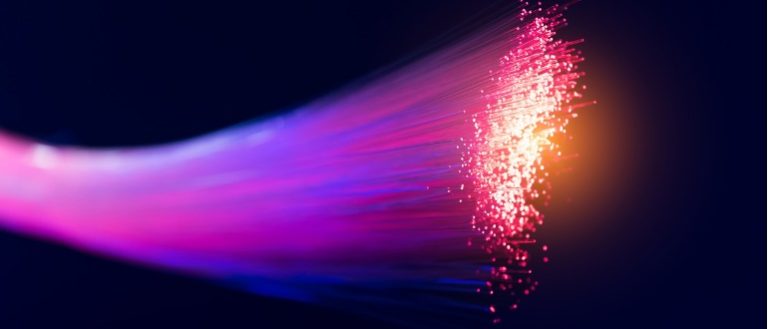How Fiber Optic Cable Works

When you’re looking for a new internet provider, you want the type of service that makes the most sense in terms of speed, reliability, and cost. You’re likely familiar with cable, wireless, and DSL as communication mediums, but fiber-optic communication systems may still be a mystery.
This cutting-edge technology harnesses the power of light and the properties of glass to send voices, data, and images across the internet. But how exactly does fiber optic cable work, and is it the best choice for your business’s needs?
In this four-part series, we dig into the science behind optical fiber and explain some of its benefits, then compare it to copper cable, wireless, and DSL. Once you’ve read the entire series and understand how fiber optic cable works, you’ll feel confident reviewing Frontier Business’s offerings in your area and knowing which package best suits you.
How Do Fiber Optic Cables Work?
Fiber-optic cables are made up of anywhere from two to several thousand strands of pure glass, each thinner than a human hair. These long glass threads are bundled into an optical fiber cable with several distinct parts:
- The core is the main part of the cable. It houses the glass fibers and is the pathway light signals travel along.
- The cladding is made of a different type of optical glass than the glass fibers, and it reflects light pulses back inside the core. This material allows the single mode signals to travel long distances without losing strength or quality (which we explain more below).
- A protective plastic coating wraps around the glass cladding.
- Strengthening fibers (made of the same material used to create Kevlar™ vests) and a final polyethylene layer protect the optical fibers from moisture or physical damage.
There are two types of fiber-optic cables: single-mode fiber and multi-mode optical fiber. Both rely on a light source to convert electrical information into pulses.
Single-mode fiber uses lasers to create the light pulses that travel long distances along a narrow core measuring nine microns in diameter. Since single-mode optical cables carry signals for distances over sixty miles, they’re often used by government or educational organizations to extend fiber-optic networks across large campuses.
Multi-mode optical fiber uses LEDs as its light source and has a core with an average diameter of fifty microns to accommodate larger glass fibers. The amount of light signals passing through a multi-mode core is greater than in single-mode, allowing more information to be transmitted at one time. Multi-mode fiber optics are best suited to shorter distances and connect networks within one building.
Multi-mode fiber is more commonly used than single-mode fiber options.
What Are the Advantages of Fiber Optics?
Optical fiber offers several benefits:
- Speed. Fiber optic signals move at 31% of the speed of light to provide faster uploads and downloads. Copper’s electrons only move at 1% of the speed of light.
- Reliability. The insulating qualities of the glass core prevent electric currents from flowing through the core, making fiber-optic networks immune to external interference. Since no electricity passes through the glass, there also isn’t a fire hazard with fiber optics. Copper, on the other hand, is not immune to electromagnetic interference and can pose a fire hazard if not carefully maintained.
- Security. Light doesn’t radiate electromagnetic signals, making fiber cable close to impossible to tap. If a security breach is attempted, light will leak out of the layers of glass and polyethylene, and the system will fail.
- Cost. The initial investment for optical fiber cable makes it more expensive in the short term, but monthly costs for the service mirror traditional internet service. Furthermore, optical cabling costs less to maintain and doesn’t require as much networking hardware as other options.
Who Uses Optical Fiber Today?
Over the last several decades, fiber optic networks have transformed the telecommunications and computer industries. Optical fiber is replacing copper cable for long-distance calls. Some industry experts estimate fiber internet has taken over the majority of internet connections and carries more than 99% of international communications.
Does that mean it’s the best choice for your business? Before you decide, learn more about the pros and cons of fiber-optic technology compared to coaxial cable, wireless, and DSL internet services. By then, you’ll be ready to invest in the internet delivery system that provides you with the right amount of capacity and capability to fit your needs.
Read Fiber vs Cable
This article is the result of impartial research. Individual research is recommended to consumers.



